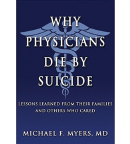Bookmark

- Title: Why Physicians Die by Suicide: Lessons Learned FromTheir Families and Others Who Cared
- Author: Michael F. Myers, MD
- Publisher: Michael F. Myers, MD
- Publication date: February 2017
- Price $14.99, paperback, 178 pages
The statistics on physician suicide are stark: Physicians are more than twice as likely to take their own lives as nonphysicians, and more than 400 physicians commit suicide each year in the United States. Moreover, young physicians at the early part of their training are reported to be particularly vulnerable to suicidal ideation. And although most residents are provided confidential counseling, too many fall through the cracks. A thoughtful new book titled Why Physicians Die by Suicide: Lessons Learned From Their Families and Others Who Cared addresses this troubling and underreported phenomenon.
“My husband, Harry Reiss, a prominent New York doctor, killed himself at the age of 43. We were married for 21 years, and I had accompanied him on the long and arduous journey through medical school, internship, residency, fellowship, and establishing a successful solo private practice as a urologist. At the prime of his career, Harry injected himself with a lethal dose of thiopental…. I found him dead in his office when he was late coming home and I could not reach him.”
So begins Why Physicians Die by Suicide, a sledgehammer opening paragraph. The author, a distinguished psychiatrist, communicates the stories of families and loved ones of physicians who have died by suicide. But more than a compilation of heart-rending personal accounts, he opens a window into the guarded and protected culture of the medical profession, shedding light on the things that have this far stood in the way of understanding why so many doctors take their own lives.
The book is organized into four parts, each of which is separated into concise chapters that follow a linear path from understanding physicians and their world, including stress, burnout, and cultural stigmas, to a conclusion that includes multiple outreach resources. Although some of the chapters feel a bit rushed, as if used to fill a page quota, the overall structure works well for this type of book: a cross between a medical memoir and a self-help guide.
Closer Look at Why
Suicide is one of the most difficult social issues to explore, and at times Dr. Myers struggles with identifying the “why” of suicide. In 2015, more than 44,000 Americans killed themselves, suggesting 1 person in the United States dies by suicide about every 12 minutes. The reasons for suicide are myriad; however, poverty has been shown to increase the risk of suicide. There is a so-called misery line of persons who earn $34,000 per year or less, and they are 50% more likely to commit suicide. Moreover, unemployed people seem to be more than 72% more likely to commit suicide than people who are employed. The data on suicide add a disturbing component to the many ills that befall those in lower socioeconomic strata.
More than a compilation of heart-rending personal accounts, the author opens a window into the guarded and protected culture of the medical profession.—
Tweet this quote
However, Dr. Myers book is about doctors, not the poor or unemployed. So, how does he explain the suicide of the 43-year-old successful, happily married urologist in the book’s introduction? Therein lies the book’s biggest challenge.
The French writer-philosopher Albert Camus wrote: “There is but one truly serious philosophical problem, and that is suicide. Judging whether life is or is not worth living amounts to answering the fundamental question of philosophy.” And answering that philosophical question becomes the book’s central problem.
Physician Burnout
Mental illness aside, the author focuses on the well-known issue of physician burnout. According to Dr. Myers, when a physician burns out, emotionally and physically, instead of taking time to see his or her own physician, he overcompensates by working that much harder, “overgives” to patients, staff, colleagues, and even takes their on-call shifts when they need someone to fill in.
“The more exhausted he becomes, the more he feels depressed, guilty, and despairing. Very sad, but not rare in the world of medicine,” writes the author. True, but that same scenario could be plugged into many other professions, leading one to believe there’s something deeper going on with doctors, perhaps an underlying cultural personality issue heretofore unnamed. Addressing physician suicide—as Dr. Myers points out in several chapters—in medical school is a good thing.
In chapter 10, “Revitalizing the Practice of Medicine,” Dr. Myers points out that it is essential for physicians to monitor themselves for signs of burnout, depression, drug and alcohol abuse, and even work-related family issues. Despite the challenges in today’s health-care system, doctoring is a noble profession, one that everyone in our society depends on. The fact that so many of those who care for us take their own lives speaks to a deeper ill in society as a whole. “Therefore,” writes Dr. Myers, “Doctors must take care of themselves as they navigate through the often rough waters of medical life.” This book is recommended for the readers of The ASCO Post.

